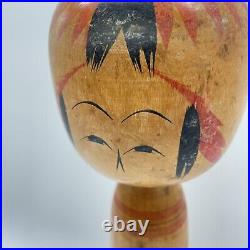
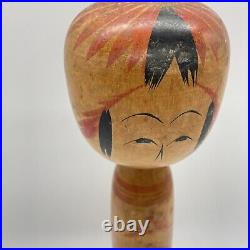
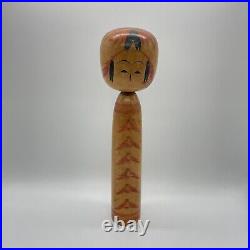
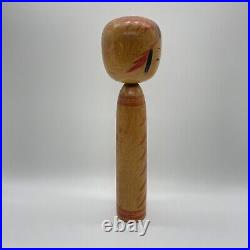
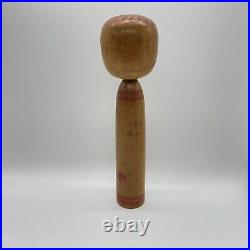
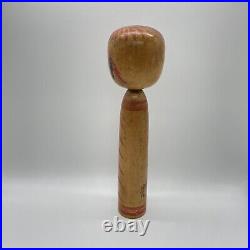
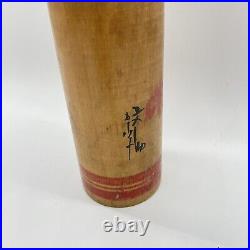
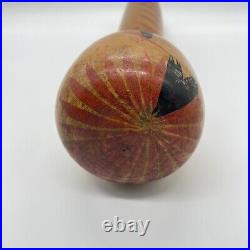


Large vintage kokeshi japanese wooden doll by Bunsuke Sato (1959) K048. Kokeshi hand made by. 11.8 inch / 38cm Tall. Disciples: Fumio Sato / Tomio Sato / Fujiumi Sato. [Profile] Born on November 23, 1901, in Aone Onsen as the second son of Bunpei and Tsune Sato. His father, Bunpei, was the second son of Bunkichi Sato of Togatta and had married Tsune, the daughter of Shichizo Sato (and niece of Shueimon Sato), becoming a son-in-law in the Sato family. At that time, Bunpei was working as a woodturner at the factories of Kuraji Tanno and Jinpei Obara in Aone. Bunsuke became familiar with the lathe and started making kokeshi and other items from around the fourth grade of elementary school. He graduated from Togatta Elementary School in 1913 and formally began training in woodturning under his father Bunpei in 1914. By around 1918, he could turn any kind of toy. Later, he mastered turning difficult items, and from 1922 to 1924, he worked as a craftsman at his uncle Bunroku’s place in Obukuro. In 1925, he worked for six months in Hanamaki and then several months again in Obukuro. In 1928, through the arrangement of Konosuke Sato, he worked at a woodturning factory in Sugitote, Morioka, managed by a certain Tokawa. In 1929, he went to Hakodate, Hokkaido. In 1939, his eldest son Fumio became his apprentice. Bunsuke was introduced as an artist in the magazine “Kokeshi” by Bunsaku Tachibana. In 1940, due to the Tohoku Development Electric Power Company acquiring water rights, he built a new factory and house in Togatta Onsen. In 1941, his eldest son Tomio began training in woodturning. From May 1945 until the end of the war, Bunsuke, along with Enkichi Sato and Rinpei Takahashi, turned military supplies at an aircraft parts company in Shiroishi. In 1947, his second son Fujiumi began woodturning training. Post-war, he continued making traditional kokeshi, toys, and horizontal woodturning products. During the second kokeshi boom, Bunsuke and Usho Sato were equally popular in Togatta. Bunsuke was known for his love of alcohol, taciturn nature, and somewhat unapproachable personality, yet he was a charming craftsman with a strong artisan spirit. He passed away on May 8, 1977, at the age of 77. [Works] He gradually resumed making kokeshi from around 1937, but works prior to this are not confirmed. His full-fledged return to kokeshi production was around 1939. The piece from 1938, shown below on the far left, is an early example. The works from 1938 and 1939 are characterized by sharp and tense expressions. Kokeshi are traditional Japanese wooden dolls, characterized by their simple yet elegant design. These dolls are made from wood and typically feature a simple cylindrical body with a rounded head. Here are some key aspects of Kokeshi dolls. Traditional Kokeshi (Dento Kokeshi). These are the original forms of Kokeshi, handcrafted and typically passed down through generations of artisans. They are classified into several regional styles, each with its own unique features and patterns, such as Naruko, Tsuchiyu, Yajiro, and others. The designs often include hand-painted floral or geometric patterns, and the dolls are usually left unvarnished. Creative Kokeshi (Shingata Kokeshi). These emerged after World War II and allow for more artistic freedom. Unlike traditional Kokeshi, they are not restricted by regional styles or patterns, leading to a variety of innovative designs and forms. They may include more elaborate decorations, different shapes, and varnished finishes. Made from different types of wood, such as cherry, dogwood, or chestnut, each providing a distinct texture and finish. Traditionally, Kokeshi dolls are lathe-turned and hand-painted. The head is often a separate piece attached to the body. Typically, the dolls have no arms or legs. The facial features are simple, often just eyes and a mouth, with minimal detail. They come in various sizes, from a few inches to over a foot tall. Kokeshi dolls are often associated with protection against evil and are believed to bring good luck. They are sometimes given as gifts for good fortune or to comfort someone who is grieving. The making of Kokeshi dolls is a respected art form, with many artisans dedicating their lives to perfecting their craft. Each region’s style represents its unique cultural heritage. While rooted in tradition, Kokeshi dolls have seen a resurgence in popularity, appealing to both collectors and those interested in traditional Japanese art and culture. Collectors often seek traditional Kokeshi made by renowned artisans, each piece often signed and dated. The value of a Kokeshi doll can vary greatly depending on its age, condition, and the reputation of the artist. They are commonly displayed in homes, both as decorative items and as symbols of cultural pride. Kokeshi dolls embody a blend of simplicity and elegance, making them cherished items in Japanese culture and a fascinating subject for collectors and enthusiasts worldwide. We do not mark merchandise values below value or mark items as? Japan, US and International government regulations prohibit such behavior. About Importer’s Obligation. Thank you for your understanding.

